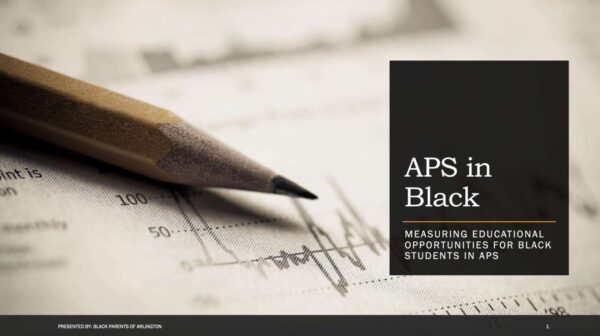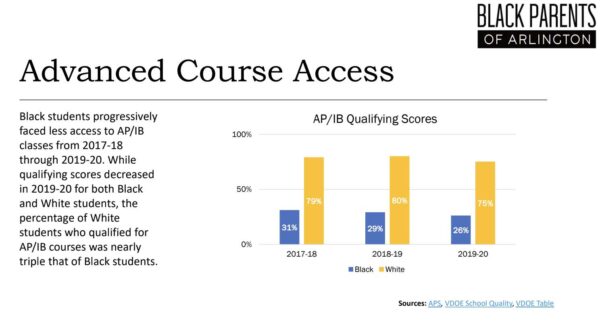
Black students in Arlington Public Schools still see lower passing rates and are more likely to be suspended than white students, an advocacy group found, as detailed in a new report.
Black Parents of Arlington, a local group founded in 2019 to advocate for the interests of Black students in the county, published “APS in Black: Measuring Educational Opportunities for Black Students” this past weekend.
The report highlighted “long standing inequities between Black and white students in APS,” according to a press release.
The organization claims that APS was “unable to dismantle the systemic racism within its foundation,” and failed to create an environment in which Black students can “thrive academically” or are given sufficient opportunities outside the classroom.
There was an approximately 20 percentage point difference in pass rates in Virginia’s Standard of Learning test between Black and white students in the 2018-2019 school year, according to the report. Black students had an around 70% pass rate in both math and reading, while white students had an around 90% pass rate across all APS schools.
Although the disparity in pass rates vary significantly in different elementary, middle and high schools, most schools showed more than a 10 percentage point gap between Black and white students in math and reading pass rates between 2017 and 2019.

While three-fourths of white students qualified for advanced courses such as AP and IB classes, only 26% of Black students did in the 2019-2020 school year, according to the group’s report.
Additionally, Black students only made up 20% or less of the population in APS middle and high schools, but were more likely than white students to be suspended in most schools, the report said.
One reason for these disparate outcomes was because of the mismatch between the demographics of teachers and that of the students, co-founder of the organization Whytni Kernodle asserted.
“Many of the African American workers in Arlington Public Schools are in central office, which means what they’re not is in front of children teaching them how to read, teaching them about algebra, teaching them about history,” she said.
As of September 2020, 44.8% of students in APS were white, while 10.2% were Black, 28.4% were Hispanic, and 8.8% were Asian, according to data from the school system.
APS needs to invest more in training and other resources to address the disparities, and to avoid entrenching the “status quo,” Kernodle said.
“If you need to change the culture of a situation or an organization, you have to use bold tactics and you have really look at who you have on the ground who’s there that should be there and who needs to be shown the door,” she said.
As of publication time APS has not offered a response to the report.
The full press release from Black Parents of Arlington is below.
In recognition of Juneteenth and at the close of the 2021-2022 academic school year, the Black Parents of Arlington (BPA) released its second “APS In Black: Measuring Educational Opportunities For Black Students In APS,” highlighting long standing inequities between Black and White students in APS. […]
This year’s Juneteenth celebration arrives at a moment when the nationwide assault on racial justice has reached a fever pitch and has energized right-wing white nationalists into a highly coordinated and well-funded offense on teaching the truth about this country’s racial history in our schools.
Juneteenth commemorates the hard-to-swallow truth about America: all enslaved people were not truly emancipated throughout the country until two and a half years after the Emancipation Proclamation. The fact that this truth was actively suppressed from so many enslaved people rings as an historical echo for the many ways in which symbolic advances for Black people continue to mask the reality of systemic oppression and anti-Black racism that perpetuate to this day.
Despite repeated calls to address academic and classroom equity for Black APS students, along with well-intended efforts of the Superintendent and his cabinet, APS has been unable to dismantle the systemic racism within its foundation and continues to fall woefully short in creating an environment where Black students can thrive academically and are presented with opportunities to build on success inside and outside the classroom.
BPA President Whytni Kernodle calls on APS to invest in training and other resources to address these racial disparities. “It’s time for APS to stop paying lip service to equity and academic disparities. For too long, we’ve been given platitudes about commitment to change, but the numbers show that much more work remains for APS to fully commit to the success of Black students. The Superintendent and the School Board must take bolder and swifter action to find the people, policies, and procedures that are standing in the way of Black achievement and remove them from our school system. This is the only way to create lasting, meaningful investments in Black students.”
Key takeaways from the report, which included data from 2017-2020:
- Suspension and disciplinary rates for Black students remain disproportionately higher than for White students across APS.
- Black students are referred to law enforcement for disciplinary action more than 50% of the time compared to White students.
- Only 15% of Black students are identified as gifted compared to nearly 33% of White Students.
- The number of White students identified for AP/IB courses was nearly triple that of Black students.
- Only 43% of Black students graduated with an advanced diploma, despite a graduation rate of nearly 99% of Black students for APS.

